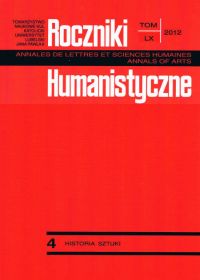Reconstruction of the 18th century woodcarving decorations in the Transfiguration of Jesus Church in Lublin in the light of archival materials
Abstract
The article is devoted to the history and decorations of the Transfiguration of Jesus Church in Lublin. The church is certainly one of the most interesting examples of baroque architecture in the map of the town.
The origin of the church is closely connected with the arrival of priests of the Congregation of the Mission to Żmigród about 1700, which happened on the initiative of Rev. Michał Tarło – the Poznań Bishop. The French priests establish their monastery and a seminary there, and with time they also build a church. The seminary complex was built thanks to numerous donations (among others by the Tarło family). The beginnings of the building fall on the 1720s. The work lasted till 1739, when the Krakow Bishop Michał Kunicki consecrated the church. This dating is confirmed by Jan Tarło's letter to the Lublin Superior of the Missionary House Mikołaj Augustynowicz of 1736. In the letter the author says that the altars for the church are ready and he is going to see them in the nearest future, when he visits the nearby Opole Lubelskie. Furnishing the Missionary church was possible owing to the efforts and donations by the magnate mentioned above.
The author of the present text undertook reconstructing the 18th century state of furnishing the Lublin church. She also followed the changes that occurred in the iconographic layer of particular elements of the mentioned interior during the following century. The basic source for the reconstruction were the materials kept in the State Record Office in Lublin concerning the funding of the altar paintings in the Missionary church and the consecration of the church. Also the 19th century inventories of the missionary furniture of the church gathered in the local Diocesan Archive supplied a lot of significant information. In the light of the documents we learn that five altars were originally the basic woodcarving furnishing of the church: the main Transfiguration of Jesus altar, and four side ones: of the Immaculate Conception, of St Barbara, of the Crucified Christ and of St Vincent de Paul. This iconography was complemented by a pulpit with the statues of the four Evangelists placed on it and a figure of Christ teaching on the finial of the baldachin.
In the 19th century the church's decoration was complemented with the next two altars: that of St Stanisław Kostka and of the Guardian Angel, as well as with the series of four great canvases illustrating the most important episodes from the life of St Vincent de Paul placed over the central nave.
Analysis of particular elements of the interior of the church has allowed the author to notice a uniform, with respect to both the form and content, set of altars, in their content layer referring to issues connected with the spirituality of the priests of the Congregation of the Mission and with the person of the donator and protector – Jan Tarło.
Basic changes in the furniture of the Lublin church occurred at the end of the 19th century, after the Missionary house had been annulled and the seminary complex had been taken over by diocesan priests. Two altars, the Stanisław Kostka and the Guardian Angel ones, were removed and some paintings were exchanged (e.g. the Conversion of St Paul, Christ – the Good Shepard). Despite the intervention, in the iconographic layer of the altars, their basic architectonic structure as well as their sculptural and decorative elements were probably preserved in their original form that was given to them by the woodcarver brothers – Jan Eliasz Hoffman and Henryk Hoffman.
The former Transfiguration of Jesus Church belonging to the St Vincent de Paul Congregation of the Mission even today is characterized by an interesting formal solution of the architecture with Czech provenance, a high level of the late Baroque sculpture, and an interesting iconographic program.
Copyright (c) 2012 Roczniki Humanistyczne

This work is licensed under a Creative Commons Attribution-NonCommercial-NoDerivatives 4.0 International License.





